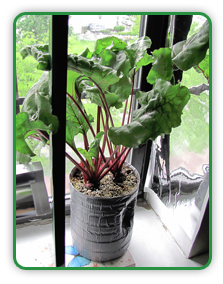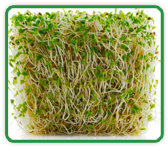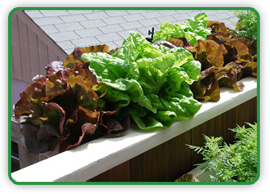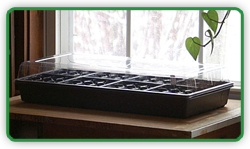|
Home > Guides > Urban Gardening > Apartment Gardening > Window Gardens |
|
Window Gardens |
Apartment  Window Window  Windowsill Windowsill  Patio Patio |
At first, the terms 'apartment' & 'gardening' seem to be something of a contradiction in terms. Gardens have traditionally been grown outdoors, in expansive spaces with long hours of afternoon sunlight. In comparison, apartments are considerably limited by sunlight and available space for seed sowing. Despite these challenges, there are some significant advantages to patio or indoor growing. Principally, such environments offer stability, with only minor fluctuations in heat and energy throughout the daily and yearly cycles. This offers potential for year-round gardening, and with persistence, a steady of supply of fresh, healthy, homegrown produce such as Lettuce and Herbs grown right on your patio, in your Window or Windowsill.
|
 |
|
|
| |
|
|
| |
|
|
| |
 Apartment Gardening Apartment Gardening
GROWING NOTES
Crops well-suited for apartment gardening are those with low to moderate light needs, minimal required soil-medium depth, and short time to harvest. Generally speaking, leafy greens or crops cultivated at a developmental stage prior to full maturity will make the best choices. Other types of edibles, including those cultivated for their root, fruit, or seed require significantly more energy and time, and are not ideal for limited space gardening. Popular leafy greens such as lettuce, arugula, kale and others have the added benefit of a shorter time to harvest, typically less than 2 months from seed to dinner plate.
 In addition to growing leafy greens indoors, baby greens, microgreens and sprouts can all be cultivated indoors with little space and energy. Unlike vegetables grown to maturity, these types of edibles do not develop mature root systems and are more limited in their abilities to take up nutrients In addition to growing leafy greens indoors, baby greens, microgreens and sprouts can all be cultivated indoors with little space and energy. Unlike vegetables grown to maturity, these types of edibles do not develop mature root systems and are more limited in their abilities to take up nutrients
from the soil. These types of growing techniques require less time than standard ones, with sprouts generally needing less than one week from seed to harvest, microgreens less than two weeks and baby greens less than one month. There
are drawbacks to these conveniences though, notably the greater quantities of
seed required for sizable yields, especially microgreens and sprouts.
|
| |
|
|
|
| |
|
|
|
|
Gardening with Windows
 Their close proximity to light makes windowsills an obvious location for planning an indoor garden. Ideally, indoor plants should be placed just beneath the window, or on shelves or terraces to make productive use of all available incoming light. If time and resources allow, constructing a windowbox specifically designed to provide maximum light to plants is a great way to foster more productive window gardens. A number of designs are available to the industrious gardnerer, or units with enclosed units with panes on multiple sides that extend off the house can be purchased. These 'mini-greenhouses' combine the best elements of modern technology with resourcefulness and common sense to enable a wide range of new possibilities in window gardening. Their close proximity to light makes windowsills an obvious location for planning an indoor garden. Ideally, indoor plants should be placed just beneath the window, or on shelves or terraces to make productive use of all available incoming light. If time and resources allow, constructing a windowbox specifically designed to provide maximum light to plants is a great way to foster more productive window gardens. A number of designs are available to the industrious gardnerer, or units with enclosed units with panes on multiple sides that extend off the house can be purchased. These 'mini-greenhouses' combine the best elements of modern technology with resourcefulness and common sense to enable a wide range of new possibilities in window gardening.
Direction and Light
 When planning your window garden, perhaps the most important consideration is which direction, and thus which windows, to set up in. In the northern hemisphere, certain guidelines will hold across most locations. The most sun will be provided by south facing windows, which will have the greatest access to sunlight as the sun completes its arc across the sky. For plants with slightly lower light needs, windows facing west or east present the next best option. After the sun reaches its peak at roughly noon, and begins to descend in the west, it can provide several hours of good quality lighting. While windows facing south, west, and east can provide enough light to support windowbox gardens, windows facing north will receive the least light and should be avoided in most locations. When planning your window garden, perhaps the most important consideration is which direction, and thus which windows, to set up in. In the northern hemisphere, certain guidelines will hold across most locations. The most sun will be provided by south facing windows, which will have the greatest access to sunlight as the sun completes its arc across the sky. For plants with slightly lower light needs, windows facing west or east present the next best option. After the sun reaches its peak at roughly noon, and begins to descend in the west, it can provide several hours of good quality lighting. While windows facing south, west, and east can provide enough light to support windowbox gardens, windows facing north will receive the least light and should be avoided in most locations.
|
|